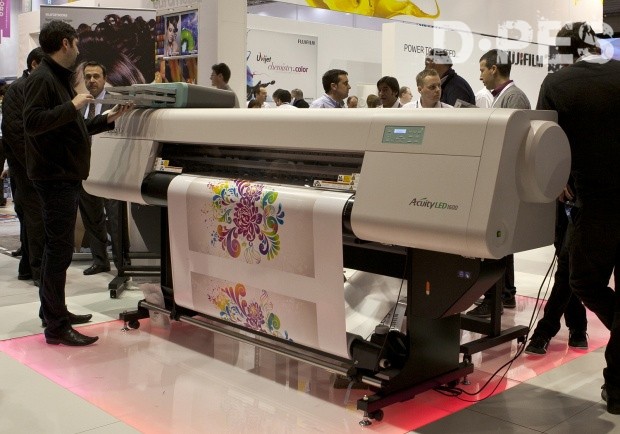The lower ranks of the UV-curable market might be well served with printers but Fujifilm's addition brings some advanced features into a sensibly priced engine. I first saw the Acuity LED 1600 at FESPA in Barcelona and, unlike the flat-beds with the same moniker (also recognisable as the Océ Arizona), this is mainly a device for roll-fed materials although it can be used with rigids up to 13mm in thickness.
These days there is little point spending valuable research and development time and funds on a chassis when plenty are available from specialist manufacturers. Thus, if the Acuity LED 1600 looks vaguely familiar, that's because the casing is built by Mimaki to Fujifilm's specification. The result is a sturdy UV-curable engine with LED curing and a production speed of 20sq m/hr. It's 1.6m wide with rigid substrates supported with the aid of a support table. It has an eight-colour ink set, with the standard CMYKLcLm being complemented with white and clear, and a maximum resolution of 1,200dpi.

Under the bonnet of the Acuity LED 1600 lie some interesting features. The print-heads employed are Dimatix Q-Class Emerald, geared up for performance graphics and incorporating 256 individually addressable channels arranged so that good throughput and drop placement accuracy are achievable even at higher speeds. The device also comes with Fujifilm's spot colour management software as standard. This enables operators to use its integrated image processing technology to create charts of any colour so that differences can be checked. This is a convenient feature in critical applications, such as when matching brand colours and logos.
The Acuity LED 1600 also features Fujifilm's Intelligent Curing Control which adjusts light from the LED lamp unit to manage the curing speed of the ink. The inks themselves are able to cover a wide colour gamut, assisted by the VersaDrop greyscale technology incorporated into the print-heads. Fujifilm says that, because the droplets merge at the nozzle rather than on the substrate, image quality is superior. The inks employed are Uvijet LL LED UV-curable products made by Fujifilm Sericol, tailored specifically for this platform.
This machine sits alongside Mimaki and Roland and should appeal to first time users of UV-curable printers or those wanting a back-up machine. Even though this market sector is well saturated with engines at a reasonable price, Fujifilm is a respected enough player not to sully its reputation by bringing out a platform which won't do what it says on the tin. Therefore, the Acuity LED 1600 offers reliability and good service options as well as being a device which includes decent print-head technology and good inks.
In terms of what it can do, although it has a flat-bed option it's clearly designed to be more of a roll-fed device which is suitable for indoor and outdoor applications. But its ability to handle rigid materials and its inclusion of white and clear could make it a useful addition to the prototyping and short-run packaging markets as well as the display sector. The inclusion of LED curing means it can handle heat sensitive materials.
It's not the cheapest in the 1.6m wide category, nor the most versatile. Nonetheless, its robust, ergonomic build and the fact that it has evolved from a company which knows more than a little about ink-jet should make it a serious consideration for anyone needing a quality platform. An additional comfort factor might lie in the fact that Fujifilm also manufactures the print-heads and the inks.
Price
£60,000
Pros and Cons
Devices using LED curing lamps aren't new to the lower end sectors of the wide-format market. But this feature, as well as its colour capabilities, should make this machine a sensible option for users wanting an engine where quality is more important than a rock bottom price. Nonetheless, the fact that it isn't the cheapest might weigh against the Acuity LED 1600 when compared with some others in this arena.
Verdict
This is a nicely constructed and finely honed 1.6m device that comes under the Fujifilm umbrella of wide-format machines. Although it is more expensive than others in this market sector, its attention to detail, colour controls and throughput speed all help to justify this additional cost. There is no reason why, in conjunction with a cutting table, the Acuity LED 1600 shouldn't serve as a useful proofing and prototyping device as well as being a versatile engine for displays, signs and labels.
Ease of use: 5/5
Speed: 4/5
Quality: 5/5
Versatility: 4/5
Value for money: 4/5